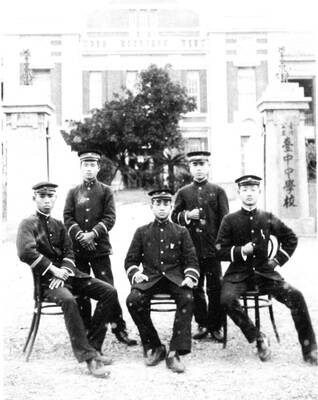The Peony Pavilion (牡丹亭) is recognized as one of Chinese civilization’s great theatrical works, and has the same kind of reputation as Shakespeare’s Romeo and Juliet, known about and referred to even by people who rarely, if ever, visit the theater. But even for those who love traditional opera, few have seen a complete version, which runs to 55 scenes and in the 1999 production hosted by the Lincoln Center for the Performing Arts in New York ran for 20 hours. It was probably the first full production of the opera in 300 years, and although that production toured extensively around the world at the time, it is not likely to be repeated any time soon.
The opera retains its grip on its audience through performances of key scenes, some of which have been incorporated into Lanting Kun Opera Troupe’s (蘭庭崑劇團) post-modern reworking of the opera, which opens on Friday at Taipei’s Metropolitan Hall (城市舞台). Through a highly technical compiling of music, lyrics and other materials by the opera’s Ming Dynasty author Tang Xianzu (湯顯祖), as well as the use of modern stagecraft, Lanting has sought to create a complete and integrated opera that both radically condenses the original, and provides a way into some of its central ideas.
Lanting has made a specialty of reworking the long, involved and discursive kun operas (崑劇) for a modern audience, most recently with a hugely successful 90-minute production of The Palace of Eternal Youth (長生殿) for the National Palace Museum (國立故宮博物院). The production opening on Friday, titled Quest for the Garden Saunter and the Interpreted Dream (尋找遊園驚夢), also began life as a 90-minute piece designed specifically for performance at what is now the Huashan 1914 Creative Park (華山1914). This production brought together kun opera, installation art and experimental theater and arguably inaugurated a new era in creative stagings of Chinese opera.
This was in 2007. There have been a number of location-specific stagings since, but this is the first time that Quest will be adapted for a theater setting. Speaking about the transfer of this production in an expanded, approximately two-hour version to a conventional stage, Wang Chih-ping (王志萍), Lanting Kun Opera Company’s director, said that given the original production’s critical success, its influence and the unique creative energy that it generated, she had been eager to create a version that was not locked into a specific venue.
The story of The Peony Pavilion revolves around a romantic relationship between Du Liniang (杜麗娘), the daughter of a powerful Song Dynasty official, and Liu Mengmei (柳夢梅), a young, impecunious scholar. The romance begins in a dream and involves the highly improbable resurrection of the heroine after she pines away for love to be reunified with her beloved. The original opera shifts between dreams, recollection and reality, and is a perfect platform for what kun opera does best: the explication of romantic thoughts and longings in beautiful and elaborate language. It is also marvelously suited to the kind of splintered, non-narrative presentation that gives this opera, written in the late 1500s, a very contemporary feel.
The nature of kun, with its focus on music and lyrics over narrative, also makes it susceptible to the kind of radical distillation to which Wang and her team have subjected it.
To provide a window into the world of kun, Wang has introduced a modern figure into the opera, a woman who serves as a kind of narrator and chorus to the action. “All her lines come from the original text,” Wang said. “When there is so much good material available, there is no need to force new material in.” The character is sung by actress and singer Sean Hung (洪瑞襄), who is participating in kun opera for the first time. Her movements and phrasing are a contrast with the laboriously honed grace of the kun professionals, creating a stylistic tension that helps ease audiences unfamiliar with kun into its highly stylized world.
Wang said the original Huashan production provided important inspiration in the area of staging. The depth of the performance area and the opportunity to use precision lighting allowed the creation of visual depth and the sense of characters being in different states or in different times, without making any of this explicit. The normal Chinese opera stage is two-dimensional by comparison, with every attention given to the performers and nothing to creating a sense of atmosphere. While Hung had her work cut out learning to sing kun, traditional performers needed to relearn some of the accepted knowledge about projecting their voices to adapt to the more complex staging.
“The Chinese opera companies have enormous depth of talent,” Wang said. “Taiwan cannot go head-to-head against them. What we can do instead is create small, innovative productions.” Wang said that for the current generation at least, radical innovation in traditional opera in China was still hampered by the narrow discipline of opera training, with few opera professionals having accesses to a broader liberal arts or theatrical education.
For this new production, Wang has brought in the talents of Wen Yuhang (溫宇航), who played the male lead in the epic Lincoln Center production in 1999. As an acknowledged master in the interpretation of The Peony Pavilion, Wang said he had provided invaluable insight in his role as both director and leading male in Quest. The female lead is played by Kong Aiping (孔愛萍), a leading performer of the Jiangsu Kun Opera Company (江蘇省崑劇院) who won the prestigious Plum Blossom Prize (梅花獎) for her performance of Du Liniang in The Peony Pavilion.
Wang said one of the reasons Lanting could attract performers of Kong’s caliber was because of the unique performance opportunities it could provide.
What Lanting has been able to do in its small but important corpus of work, and perhaps most spectacularly in Quest, is to show the potential of kun as an expressive medium for modern interpretations of classic stories. What is achieved is not a fusion of ancient and modern, but rather a careful pruning of an ancient tradition to highlight elements in which a modern audience can find value and inspiration.

In the March 9 edition of the Taipei Times a piece by Ninon Godefroy ran with the headine “The quiet, gentle rhythm of Taiwan.” It started with the line “Taiwan is a small, humble place. There is no Eiffel Tower, no pyramids — no singular attraction that draws the world’s attention.” I laughed out loud at that. This was out of no disrespect for the author or the piece, which made some interesting analogies and good points about how both Din Tai Fung’s and Taiwan Semiconductor Manufacturing Co’s (TSMC, 台積電) meticulous attention to detail and quality are not quite up to

April 28 to May 4 During the Japanese colonial era, a city’s “first” high school typically served Japanese students, while Taiwanese attended the “second” high school. Only in Taichung was this reversed. That’s because when Taichung First High School opened its doors on May 1, 1915 to serve Taiwanese students who were previously barred from secondary education, it was the only high school in town. Former principal Hideo Azukisawa threatened to quit when the government in 1922 attempted to transfer the “first” designation to a new local high school for Japanese students, leading to this unusual situation. Prior to the Taichung First

Chinese Nationalist Party (KMT) Chairman Eric Chu (朱立倫) hatched a bold plan to charge forward and seize the initiative when he held a protest in front of the Taipei City Prosecutors’ Office. Though risky, because illegal, its success would help tackle at least six problems facing both himself and the KMT. What he did not see coming was Taipei Mayor Chiang Wan-an (將萬安) tripping him up out of the gate. In spite of Chu being the most consequential and successful KMT chairman since the early 2010s — arguably saving the party from financial ruin and restoring its electoral viability —

The Ministry of Education last month proposed a nationwide ban on mobile devices in schools, aiming to curb concerns over student phone addiction. Under the revised regulation, which will take effect in August, teachers and schools will be required to collect mobile devices — including phones, laptops and wearables devices — for safekeeping during school hours, unless they are being used for educational purposes. For Chang Fong-ching (張鳳琴), the ban will have a positive impact. “It’s a good move,” says the professor in the department of